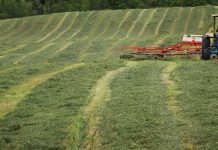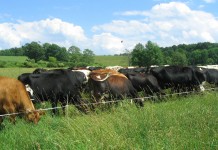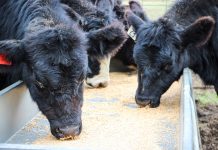Testing the nutrient value of forage is a valuable tool that can be utilized to balance livestock rations. Guessing the nutrient content of a major feed ingredient such as hay or silage can be costly to livestock producers.
For example, the Dairy One Forage Lab maintains a feed library listing the range in nutrient content of various forages and feeds. For mixed grass hay from 5/2000-4/2010 they have analyzed more than 35,000 forage samples.
Utilizing corn, soybean meal, feed limestone and dicalcium phosphate we can establish a price for energy, protein, calcium and phosphorus and compare the value of mixed grass hay based on the laboratory range in hay nutrient content.
Results
Utilizing current prices from our local feed supplier as of 10/26/10, the range in nutrient value of the mixed grass hay tested at the Dairy One Laboratory was $207 per ton to $150 per ton. The average value of the hay was $182 per ton. The difference in value from top to bottom is over $56 dollars per ton. The value difference from the average to the low quality hay is over $31 per ton.
To realize the value in hay or other stored forage we need an analysis. Most livestock producer will need to supplement this winter with some kind of stored forage. High prices for soybean meal, corn and other commodities further justify the cost of a forage analysis.
Forms
Forage test forms can be obtained from your county Extension office. These forms contain complete instructions on how to collect forage samples.
Proper collection and identification of a sample is very important. A tool is needed to collect hay samples. Your local Extension office may have a Penn State Forage Sampler. This device consists of a long tube with a cutting edge on one end and a shank on the other that can be fastened to an electric drill or hand brace.
1. To correctly sample a rectangular bale, the bit is driven into the end of 15 to 20 bales from a particular lot of hay. Drill to the full depth of the sample tube on loose bales and half depth in tight bales. Mix the cores thoroughly and send the entire sample to the lab in a sealed plastic bag.
2. Large round bales should be sampled on the rounded side of the bale. Collect a single sample from each of 10 to 12 bales from the same lot, combining the core samples into one sample for analysis. If the outer layer of the round bale is weathered, pull away 1 to 2 inches and sample below. Drill to the full depth of the tube.
Each hay type and cutting should be sampled and analyzed separately. Hay harvested on different dates within a cutting should also be sampled separately. Therefore, it is important that each cutting is stored separately and can be identified with its forage test.
When sampling forages one cannot over stress the importance of proper sampling technique. Samples should be representative and selected at random. In summary, sample each lot of forage separately, and make sure that the forage can be identified with its analysis when feeding.
Additionally
Silage can also be analyzed. To sample silage, run the unloader and collect from the feed bunk in five to six places. Put four handfuls of silage into a plastic bag. Collect samples for two or three days, then mix thoroughly and subsample 1 to 2 pounds.
Keep samples in the refrigerator during the collection period and store them in a plastic bag. Seal the bag, attach a completed tag and mail immediately or freeze and mail the frozen sample to the laboratory. Bagged silage can be sampled by cutting slits along the side of the bag in five to six places.
Collect handfuls and mix in a clean plastic bucket. Mix well and bag in plastic with a tag. Reseal the slit with heavy duty tape. Silage can also be sampled while it is going into the silo. Collect representative samples from each wagon as it is unloaded and mail immediately or freeze the samples.
Take the same number of samples from each wagon and keep them in a container. If the silage lot changes (i.e., a particular hybrid, field, area of the farm), start another container. When all samples have been collected, mix the sample within each container, and collect a random 1- to 2-pound subsample for analysis.
Mailing
Seal in a plastic bag and send to the lab immediately or freeze if they can’t be mailed promptly. Fresh silage samples are a good way to plan your feeding program. However, it is a good idea to sample silages when they are being fed and have gone through the fermentation process.
Pastures can be sampled by collecting pasture grass at the height animals are grazing. Collect random grab samples of forage from several locations. Air dry the sample if possible, before sending to the laboratory. This can be done by hanging the forage inside a burlap bag for about a week. Fresh samples should be mailed immediately.
Knowing the forage nutrient content can save money in the winter feed program. A forage analysis is the only way to accurately balance a ration or mineral program. Lastly, the forage analysis determines forage value.
For assistance contact an OSU Extension, Agriculture and Natural Resource Educator.












